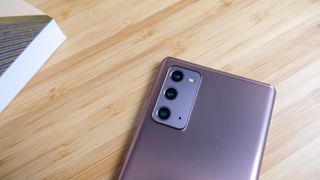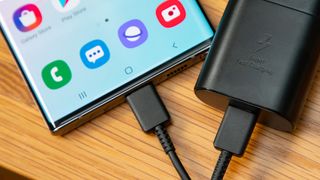Samsung Galaxy Note 20 vs Galaxy Note 10: What’s different
If you’re eyeing the new Samsung Galaxy Note 20, but would rather not spend over a grand on a new phone, we have a bit of good news to share. Not only does the new Note 20 cost $999, but the arrival of Samsung’s latest phablet signals the departure of the Galaxy Note 10, which started at $949 when new and will likely see prices slide as retailers unload remaining stock.
The more affordable, 6.7-inch variant of Samsung’s upcoming phablet is $50 more expensive than last year’s Galaxy Note 10. So it’s worth comparing the two generations of Note models to highlight what’s changed in the last year. Read on for an analysis of the Galaxy Note 20 vs Note 10, and a deeper dive into what buyers will get (and lose) in the newest iteration of one of the best Android phones.
Galaxy Note 20 vs Galaxy Note 10: Price and availability
The Galaxy Note 20 costs $999 and only comes in one configuration with 128GB of storage and 8GB of RAM. Interestingly, that’s less storage than the Note 10, which has twice the capacity at 256GB, and costs $949.
Neither device makes room for a microSD card slot, so you can’t expand space for apps and media; you’re stuck with what you have out of the box. For that privilege, you’ll have to move up to either the Note 20 Ultra or Note 10 Plus.
Like the Note 10 before it, the Note 20 will be available from all major carriers as well as unlocked for use on any network. It comes in three colors: Mystic Gray, Mystic Green and Mystic Bronze. The Note 10 had four options: Aura Glow, Aura White, Aura Black and Aura Blue.
Galaxy Note 20 vs Galaxy Note 10: Specs
| Galaxy Note 20 | Galaxy Note 10 | |
|---|---|---|
| Price | $999 | $949 |
| Display | 6.7-inch AMOLED (FHD; 60Hz) | 6.3-inch AMOLED (FHD; 60Hz) |
| CPU | Snapdragon 865 Plus | Snapdragon 855 |
| RAM | 8GB | 12GB |
| Storage | 128GB | 256GB |
| microSD Slot? | No | No |
| Rear camera | 12MP wide (ƒ/1.8); 64MP telephoto with 3x lossless zoom (ƒ/1.8); 12MP ultrawide (ƒ/2.2) | 12MP wide (ƒ/1.5-2.4); 12MP telephoto with 2x optical zoom (ƒ/2.1); 16MP ultrawide (ƒ/2.2) |
| Front camera | 10MP (ƒ/2.2) | 10MP (ƒ/2.2) |
| Battery | 4,300 mAh | 3,500 mAh |
| Connectivity | 56 (sub-6GHz and mmWave), 4G LTE | 4G LTE |
| OS | Android 10 with One UI 2.0 | Android 10 with One UI 2.0 |
| Colors | Mystic Gray, Mystic Green, Mystic Bronze | Aura Glow, Aura White, Aura Black, Aura Blue |
| Size | 6.36 x 2.96 x 0.32 inches | 5.9 x 2.8 x 0.31 inches |
| Weight | 6.84 ounces | 5.9 ounces |
Galaxy Note 20 vs Galaxy Note 10: Design and display

What’s most obvious out of the gate is how much bigger the Galaxy Note 20 is compared to the Galaxy Note 10. The newer model’s display is four-tenths of an inch larger, which translates to a device that’s roughly the same margin wider and nearly two-tenths of an inch taller. The Note 20 also weighs a full ounce more.
This is an interesting development, precisely because Samsung prided itself on how compact the Note 10 was last year. That device was supposed to bring the Note experience down to users who prefer more pocketable and less imposing handsets. However, the new Note 20 carries a display just a tenth of an inch smaller than that in last year’s Galaxy Note 10 Plus, making it clear that Samsung wanted to go big with this generation.

On the back, the Note 20 adopts a rectangular camera stack that is a bit boxier and more pronounced than the one on its predecessor, though clearly less obnoxious than what you get on the Note 20 Ultra. The back of the Note 20 also employs polycarbonate, rather than glass like in the Note 10, to keep costs down.
But back to the displays in these phones, because they’re actually more similar than one might probably hope. While the Note 20’s AMOLED panel is sized at 6.7 inches to the Note 10’s 6.4 inches, they both have the same full-HD resolution and 60Hz refresh rate. Only the Galaxy Note 20 Ultra offers the twice-as-smooth 120Hz refresh rate and adaptive LTPO technology.
The Note 20’s only measurable display advantage compared to last year’s phone is the reduced latency of inputs with the S Pen. On the Note 10, the delay was roughly 45ms; on the Note 20, it’s been reduced by 40% to 26ms. This makes for an even more responsive writing and drawing experience on the new model.
Galaxy Note 20 vs Galaxy Note 10: Cameras

Both Samsung phablets for 2020 and 2019 incorporate triple-lens cameras, though the optics and sensors underneath the glass differ.
The Galaxy Note 20’s primary camera is rated at the same 12 megapixels of the Note 10’s, but it loses the old phone’s dual-aperture system (remember when Samsung was really invested in that?) for a static ƒ/1.8 lens. The ultrawide camera on the new phone is of a lower resolution than the outgoing Note’s — 12MP versus 16MP — though the ƒ/2.2 aperture is identical.
The biggest upgrade to the imaging stack, however, relates to the telephoto lens. In the Note 20, it’s a 64-MP unit capable of 3x lossless zoom, as it simply crops into the frame to gain a closer vantage point, thanks to that wealth of pixels. The Note 10, conversely, had a 12-MP telephoto that offered a 2x optical advantage over the primary camera.
That 64-MP sensor also enables the Note 20 to capture 8K video, which isn’t possible with the Note 10. Meanwhile, the front-facing cameras look to be the same between the two phones — single-lens, 10-MP components with ƒ/2.2 apertures — and the same gear is used in the Note 20 Ultra as well.
We’ve still yet to snap some photos with the regular Galaxy Note 20. However, we’ve had extensive time with the Note 20 Ultra’s cameras and came away very impressed by the detail offered by that phone’s 108-MP primary sensor and 5x optical zoom. Of course, the cheaper Note 20 lacks these attributes, and so we’re not expecting quite the same quality of photos from the $999 variant. Check out our Galaxy Note 20 Ultra vs. iPhone 11 Pro Max camera face-off for a deeper look into the pricier Note’s photo-taking abilities.
Galaxy Note 20 vs Galaxy Note 10: Performance

The Galaxy Note 20’s biggest advantage over its predecessor, at least on paper, will likely be in the performance realm. That’s because the new phablet has Qualcomm’s latest premium system-on-chip — the Snapdragon 865 Plus — while last year’s Note 10 had the Snapdragon 855.
According to Qualcomm, the 865 boasts a 25% increase to CPU performance and a 20% increase to GPU performance over the 855; the 865 Plus adds another 10% in both columns on top of the standard 865. Indeed, the Note 20 Ultra, which we have benchmarked, achieved a Geekbench 5 score of 3,294 to the Note 10’s 2,704 points. The cheaper Note 20’s score should land in a similar place, as it has the same processor as the Ultra.
Both the Note 20 and Note 10 feature 8GB of RAM, which is pretty much the minimum you can expect in flagship handsets these days — even the new OnePlus Nord has 12GB, just like the Galaxy Note 20 Ultra. Overall, the Note 10 was an exceptionally fast device last year and is still every bit as snappy today, though if you want the absolute peak performance possible in an Android phone, the 865 Plus-toting Note 20 is calling.
Galaxy Note 20 vs Galaxy Note 10: Battery

The Galaxy Note 20 has a larger display and more powerful chipset than the Note 10, as well as 5G connectivity. Thus, it deserves a bigger battery to keep it chugging through the day, and so Samsung has responded appropriately, stuffing a 4,300-mAh unit inside its $999 phablet.
That’s 800 mAh larger than the 3,500-mAh battery inside the Note 10, which delivered just shy of 9-and-a-half hours of longevity in Tom’s Guide’s custom battery test last year. That’s not a fantastic result, especially as newer Galaxy handsets have clocked upwards of 11 hours in the very same test. The Note 20 Ultra turned in 10 hours and 26 minutes, and so we expect the regular Note 20 to fall somewhere below that, yet above the Note 10.
Both phones come with 25-watt charging adapters packed in, which allowed our Note 10 to hit 47% capacity from dead in just a half hour of charging. The Note 20 is still said to reach 50% in thirty minutes, so there shouldn’t be a massive change on that front.
Galaxy Note 20 vs Galaxy Note 10: S Pen and features

On the surface, the Note 20 and Note 10 both employ Samsung’s One UI 2.0 front end atop Android 10, for a similar user experience. However, Samsung is introducing some new productivity-minded features in the Note 20, some of which are centered around the S Pen.
There’s a new set of navigation gestures designed to make the device easier to get around when you have a stylus in hand, as well as a new feature where you can append audio recordings to written or typed notes, then play them back when tapped with the stylus. Samsung Notes has also seen a big update with the Note 20 that allows it to sync across multiple devices — be it PCs, tablets, other Samsung products and so on — and Microsoft Outlook and OneNote are also supported at the system-level for seamless syncing, too.
Samsung DeX also now supports wireless projection to a monitor or TV via Miracast, meaning you don’t even need a special USB-C-to-HDMI cable or dock to use your Note 20 like a makeshift desktop computer.
Fortunately for Note 10 owners, Samsung appears to be including a number of these features in its One UI 2.5 software update for older devices, according to SamMobile. That means it’s quite possible they won’t all stay exclusive to the Note 20 for long. Theoretically, there is no reason why the S Pen gestures and updated Samsung Notes experience can’t be extended to previous devices, so we hope the company brings over as much as it can for the existing Note faithful.
Galaxy Note 20 vs Galaxy Note 10: Outlook
As this Galaxy Note 20 vs Galaxy Note 10 face-off has shown, the Galaxy Note 20 presents an improvement above the Note 10 in many ways, though certainly not as much as the pricier Note 20 Ultra.
The new entry-level Note handset is more powerful, with a bigger display, slightly more sophisticated camera system and a battery that should last far longer through the day. The one major drawback is storage capacity — if Samsung isn’t going to give Note 20 owners the ability to expand storage, the company desperately needs to offer a higher-capacity version, because 128GB isn’t that much in a phone made for 8K video recording.
You can look forward to our hands-on impressions and review of the new Galaxy Note 20 soon.


